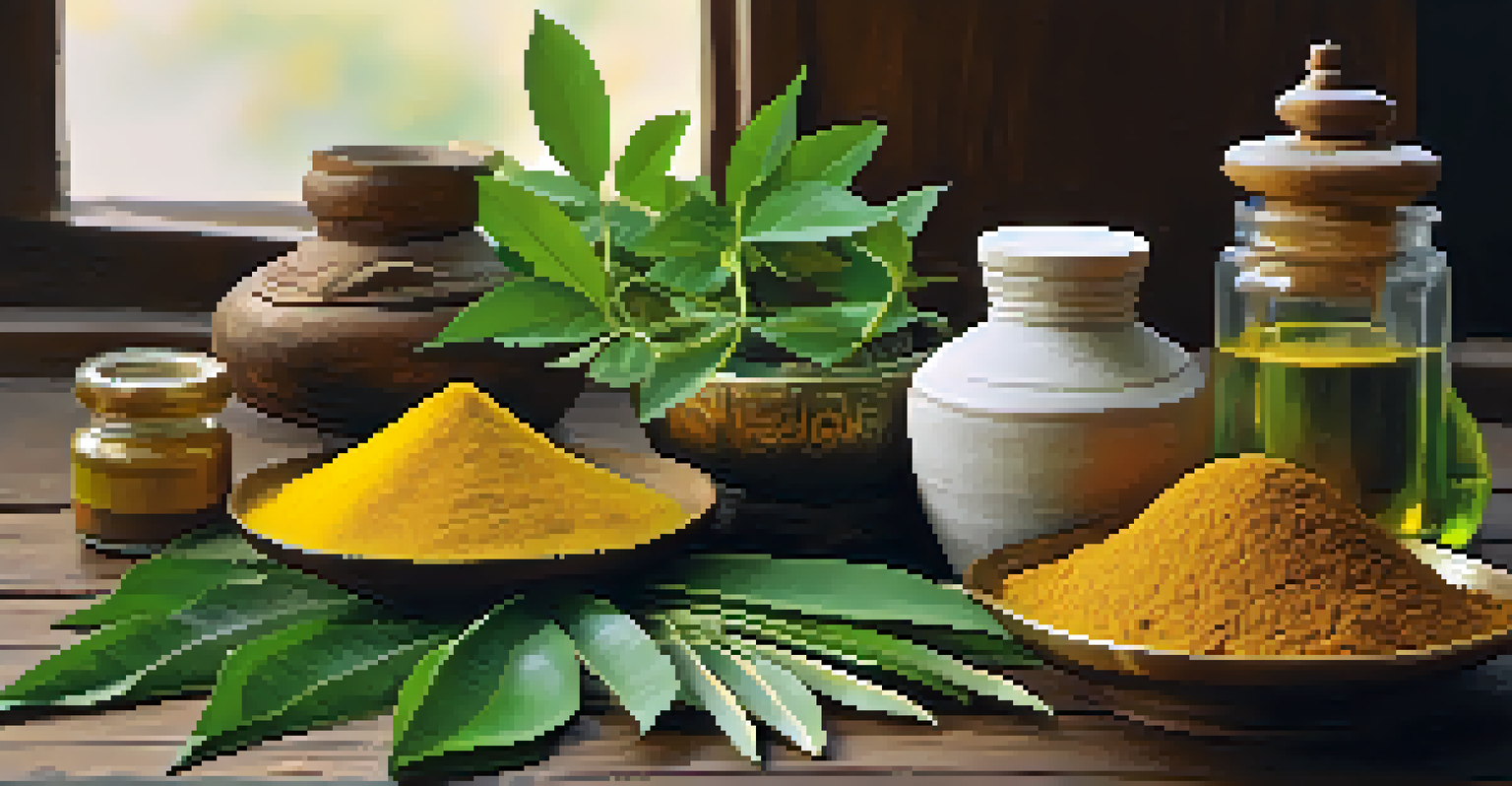Unraveling the Secrets of Siddha Medicine in South India

Understanding the Roots of Siddha Medicine
Siddha medicine, one of the oldest medical systems, has its origins in South India, dating back thousands of years. It is deeply intertwined with the Tamil culture and language, reflecting a holistic approach to health and wellness. This traditional system emphasizes not only physical ailments but also mental and spiritual well-being, illustrating a comprehensive view of human health.
The greatest medicine of all is teaching people how not to need it.
At the heart of Siddha practices lies the belief in the five elements: earth, water, fire, air, and space. These elements are thought to influence both the body and the environment, guiding practitioners in diagnosing and treating illness. Additionally, Siddha medicine incorporates the concept of 'doshas' or bodily humors, which play a crucial role in maintaining balance and harmony within the body.
The teachings of Siddha medicine are attributed to ancient sages known as 'Siddhars,' who were believed to possess extraordinary wisdom and healing abilities. Their writings, often poetic in nature, include detailed descriptions of herbs, minerals, and therapeutic techniques that continue to inform contemporary practices.
The Role of Herbs and Natural Remedies
Herbs are the cornerstone of Siddha medicine, with practitioners relying on a vast array of plants and natural substances for healing. For instance, turmeric is renowned for its anti-inflammatory properties, while neem is often used for its cleansing effects. Each herb is chosen for its unique qualities, and their combination is tailored to the individual’s specific health needs.

The preparation of Siddha medicines involves intricate processes, including boiling, grinding, and fermenting. These methods are believed to enhance the efficacy of the herbs, transforming them into powerful remedies. The careful selection and preparation underscore the deep respect Siddha practitioners have for nature and its healing potential.
Holistic Approach to Health
Siddha medicine emphasizes the interconnectedness of physical, mental, and spiritual well-being through its traditional practices.
Moreover, Siddha medicine embraces the use of minerals and metals, which may come as a surprise to those unfamiliar with traditional healing practices. These substances are treated with high reverence and are believed to possess unique therapeutic properties, contributing to the holistic approach of Siddha treatments.
Diagnosis and Treatment in Siddha Medicine
The diagnostic process in Siddha medicine is both artful and scientific, often beginning with a detailed patient history. Practitioners assess not only physical symptoms but also emotional and environmental factors that might contribute to health issues. This thorough approach allows for a more personalized treatment plan.
Nature itself is the best physician.
One common method of diagnosis is the observation of the pulse, known as 'Nadi pariksha.' This technique involves feeling the pulse at different points on the wrist to gain insights into the body's internal state. It's akin to reading a book, where each pulse reveals chapters of the patient’s health story.
Treatment plans in Siddha medicine can include a combination of herbal remedies, dietary changes, yoga, and meditation. This multifaceted approach not only addresses the immediate health concern but also promotes overall wellness, encouraging individuals to take charge of their health journey.
The Importance of Diet and Lifestyle
In Siddha medicine, diet and lifestyle are considered crucial components of health, often regarded as the first line of defense against disease. Practitioners emphasize consuming a balanced diet tailored to an individual's constitution, or 'prakriti,' which can vary widely from person to person. This personalized approach ensures that dietary choices align with the unique needs of the body.
Traditional Siddha diets often incorporate a variety of whole foods, including grains, legumes, vegetables, and spices, promoting natural healing and vitality. For example, foods rich in fiber and antioxidants are favored for their health benefits, while processed foods are discouraged due to their potential negative impact on overall well-being.
Role of Herbs in Healing
Herbs and natural remedies are central to Siddha medicine, where their unique properties are carefully chosen and prepared for individual health needs.
Moreover, lifestyle practices such as yoga and meditation are integral to Siddha philosophy. These disciplines not only enhance physical health but also foster mental clarity and emotional stability, creating a holistic framework for a balanced life.
Siddha Medicine and Modern Research
As interest in alternative medicine grows, Siddha medicine is gaining attention from the scientific community. Researchers are beginning to explore the efficacy of various Siddha remedies, seeking to validate traditional practices through modern scientific methods. This convergence of ancient wisdom and contemporary research holds exciting potential for future healthcare.
One notable area of study involves the antimicrobial properties of certain Siddha herbs, which have shown promise in laboratory settings. As scientists uncover the active compounds within these plants, they are paving the way for new treatments that could complement conventional medicine.
However, the journey of integrating Siddha medicine into modern healthcare is not without challenges. There remains a need for rigorous clinical trials and standardized protocols to ensure safety and efficacy, but the ongoing dialogue between traditional practitioners and modern researchers is a step in the right direction.
Challenges Facing Siddha Medicine Today
Despite its rich history, Siddha medicine faces several challenges in the modern era. One major issue is the lack of standardized practices and regulations, which can lead to inconsistencies in treatment and quality of care. This lack of uniformity can be disheartening for both practitioners and patients seeking reliable healing methods.
Additionally, the dwindling number of traditional practitioners poses a significant concern. As younger generations gravitate toward modern medicine, there is a risk of losing invaluable knowledge and practices that have been passed down for centuries. This generational gap highlights the urgent need for educational initiatives to preserve and promote Siddha healing.
Future Integration with Modern Medicine
As interest in holistic therapies grows, Siddha medicine is being increasingly recognized for its potential to complement conventional healthcare practices.
Moreover, the challenge of integrating Siddha medicine into mainstream healthcare systems remains a formidable task. Bridging the gap between traditional practices and modern medical standards is crucial for fostering greater acceptance and understanding among healthcare providers and patients alike.
The Future of Siddha Medicine
Looking ahead, the future of Siddha medicine appears promising, especially as global interest in holistic and alternative therapies continues to rise. There is a growing recognition of the value of traditional practices in promoting overall health, leading to greater acceptance and integration into mainstream healthcare. This shift could pave the way for a more inclusive approach to wellness that honors both ancient and modern healing methods.
Innovative collaborations between Siddha practitioners and modern researchers could lead to groundbreaking discoveries that enhance the understanding of health and disease. By combining traditional wisdom with scientific inquiry, we can unlock new potentials for healing and well-being.

Ultimately, the preservation of Siddha medicine is not just about maintaining a cultural heritage; it's about providing diverse options for health care in a rapidly changing world. As more people seek personalized and holistic solutions, Siddha medicine has the potential to play a vital role in shaping the future of health and wellness.